Japenese culturl 用英语介绍的日本文化
Japenese culturl 用英语介绍的日本文化

THANKS!
dessert
kimono 和服
Women's kimonos
Kimono is Japan's national costume, the highly traditional Japanese culture for hundreds of years and the Japanese life closely linked. Even today, whenever there's a holiday or a wedding, funeral, graduation ceremonies and celebrations such as a grand occasion, the Japanese kimono is still the first choice. 和服是日本的民族服装, 极富日本传统文化特色,千百年 来与日本人的生活息息相连。直 到现在,逢年过节或在婚礼、葬 礼、毕业典礼及庆祝会等隆重场 合上,和服仍是日本人的首选。
JAPANESE CULTURE
•Food • Cloth • Hot spring • Cherry
blossom
Food
Japanese cuisine 日式美食
shrimp tempura炸虾 sushi寿司 vegetable tempura(什锦蔬菜天妇罗) sake sashimi日本生鱼片 Rice and vegetable roll 饭团 Japanese ramen日式拉面
Hot spring
A hot spring bath proves to be an efficient therapy(疗法) for one to keep fit as well as a miraculous(超 自然的,奇迹般的) way of skin care.
日本文化英语作文

日本文化英语作文Japan is a country with a rich and unique culture. From traditional tea ceremonies to modern anime, Japaneseculture has something for everyone. 。
One of the most iconic aspects of Japanese culture is its cuisine. Sushi, ramen, and tempura are just a few of the delicious dishes that Japan has to offer. The attention to detail and presentation in Japanese food is truly remarkable.Another fascinating aspect of Japanese culture is its traditional arts, such as ikebana (flower arranging) and origami (paper folding). These art forms require patience and precision, and they have been passed down through generations.Japanese festivals are also a big part of the culture. From the cherry blossom festivals in spring to the lantern festivals in summer, there is always something to celebratein Japan. These festivals are a great way to experience the vibrant and lively atmosphere of Japanese culture.Japanese fashion is another aspect of the culture thatis well-known around the world. From traditional kimono to modern streetwear, Japanese fashion is always evolving and pushing boundaries.Overall, Japanese culture is a fascinating mix of tradition and modernity. Whether you are interested in food, art, festivals, or fashion, there is something in Japanese culture that will capture your interest.。
Japenese_culturl
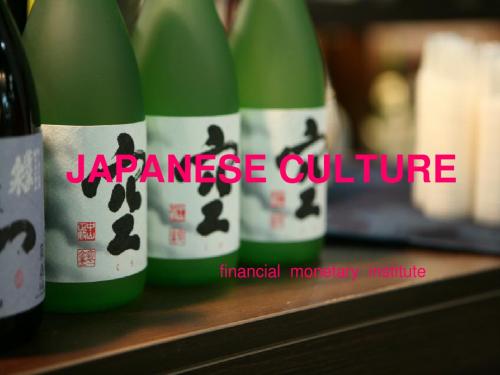
THANKS!
GREETING
In Japan, people greet each other by bowing. A bow ranges from a small nod of the head to a long, 90 degree bend at the waist. If the greeting takes place on tatami floor(榻榻米), people get on their knees in order to bow.
onsen
cherry
ORIGIN:
From 1912, when the governor of Tokyo presented to Washington 3000 cherry trees as a symbol of peace, the United States government to full bloom plexus dogwood back to japan. Washington some folk groups initiated to hold the first session, Cherry Blossom Festival, then continued, as once a year event, known the United States and the world.
kimono 和服
Women's kimonos
Kimono is Japan's national costume, the highly traditional Japanese culture for hundreds of years and the Japanese life closely linked. Even today, whenever there's a holiday or a wedding, funeral, graduation ceremonies and celebrations the Japanese kimono is still the first choice. 和服是日本的民族服装, 极富日本传统文化特色,千百年 来与日本人的生活息息相连。直 到现在,逢年过节或在婚礼、葬 礼、毕业典礼及庆祝会等隆重场 合上,和服仍是日本人的首选。
日本的风俗习惯英语作文
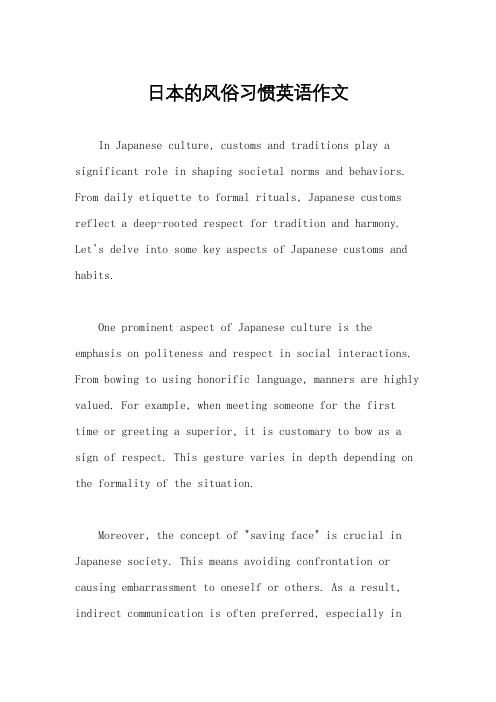
日本的风俗习惯英语作文In Japanese culture, customs and traditions play a significant role in shaping societal norms and behaviors. From daily etiquette to formal rituals, Japanese customs reflect a deep-rooted respect for tradition and harmony. Let's delve into some key aspects of Japanese customs and habits.One prominent aspect of Japanese culture is the emphasis on politeness and respect in social interactions. From bowing to using honorific language, manners are highly valued. For example, when meeting someone for the first time or greeting a superior, it is customary to bow as a sign of respect. This gesture varies in depth depending on the formality of the situation.Moreover, the concept of "saving face" is crucial in Japanese society. This means avoiding confrontation or causing embarrassment to oneself or others. As a result, indirect communication is often preferred, especially indelicate or sensitive matters. It's common to use subtle cues and non-verbal expressions to convey one's thoughts or feelings.Another aspect of Japanese customs is the importance of harmony and group cohesion. This is evident in various social settings, such as the workplace and community activities. Decision-making often involves consensus-building and considering the collective welfare rather than individual preferences. Additionally, hierarchical relationships are respected, with deference shown to those in authority or seniority.Closely tied to Japanese customs are traditional ceremonies and rituals. These ceremonies mark significant life events and seasons, such as coming-of-age ceremonies, weddings, and New Year celebrations. Each ritual is imbued with symbolism and cultural meaning, reinforcing a sense of identity and belonging.Japanese cuisine also reflects cultural values and customs. The meticulous preparation of food, attention topresentation, and emphasis on seasonality are integral tothe dining experience. Meals are often shared with others, fostering camaraderie and strengthening social bonds. Moreover, there are specific etiquettes to follow, such as using chopsticks correctly and expressing gratitude before and after a meal.Furthermore, the concept of omotenashi, or hospitality, is deeply ingrained in Japanese culture. Whether welcoming guests into one's home or providing service in aprofessional setting, the focus is on anticipating theneeds of others and ensuring their comfort and satisfaction.In addition to these customs, Japan's rich history and religious traditions continue to influence contemporary practices. Shinto and Buddhist rituals are observed in various aspects of life, from shrine visits to funerals. These spiritual beliefs contribute to a sense of reverence for nature and ancestors.In conclusion, Japanese customs and habits are multifaceted, reflecting a blend of tradition, etiquette,and cultural values. From everyday interactions to formal ceremonies, these customs serve to maintain harmony, respect, and a sense of community in Japanese society.。
日本的英语作文
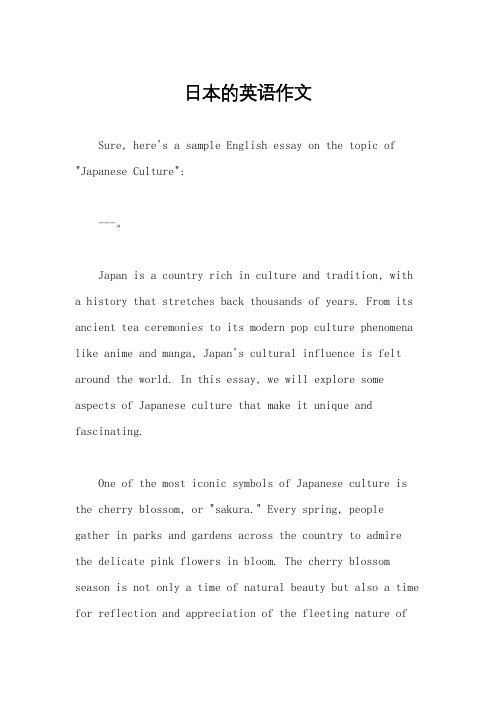
日本的英语作文Sure, here's a sample English essay on the topic of "Japanese Culture":---。
Japan is a country rich in culture and tradition, with a history that stretches back thousands of years. From its ancient tea ceremonies to its modern pop culture phenomena like anime and manga, Japan's cultural influence is felt around the world. In this essay, we will explore some aspects of Japanese culture that make it unique and fascinating.One of the most iconic symbols of Japanese culture is the cherry blossom, or "sakura." Every spring, people gather in parks and gardens across the country to admire the delicate pink flowers in bloom. The cherry blossom season is not only a time of natural beauty but also a time for reflection and appreciation of the fleeting nature oflife.Another important aspect of Japanese culture is its emphasis on etiquette and politeness. From a young age, Japanese children are taught the importance of respecting others and behaving in a manner that brings honor to themselves and their families. This emphasis on etiquette can be seen in many aspects of daily life, from bowing to others as a sign of respect to removing one's shoes before entering a home.Japanese cuisine is also renowned around the world for its delicious flavors and meticulous preparation. Traditional Japanese dishes like sushi, tempura, and ramen have become increasingly popular in other countries, and many people enjoy trying authentic Japanese cuisine at restaurants or even attempting to cook it themselves at home. The emphasis on fresh, seasonal ingredients and beautiful presentation is a hallmark of Japanese cooking.In addition to its traditional culture, Japan is also known for its cutting-edge technology and innovation. Frombullet trains to robotics, Japan is constantly pushing the boundaries of what is possible and shaping the future of technology. This combination of traditional culture and modern innovation is evident in many aspects of Japanese society, from its architecture to its fashion.One aspect of Japanese culture that has gained widespread popularity in recent years is anime and manga. These forms of entertainment, which encompass a wide range of genres and styles, have a dedicated fanbase both in Japan and around the world. Anime and manga have become a significant part of global pop culture, with conventions, cosplay events, and fan communities celebrating the creativity and imagination of Japanese creators.In conclusion, Japanese culture is a rich tapestry of tradition, innovation, and creativity. From its ancient rituals to its modern-day entertainment, Japan continues to captivate and inspire people around the world. Whether it's enjoying a cup of matcha tea or watching the latest anime series, there's something for everyone to appreciate about Japanese culture.。
日本的介绍英语作文
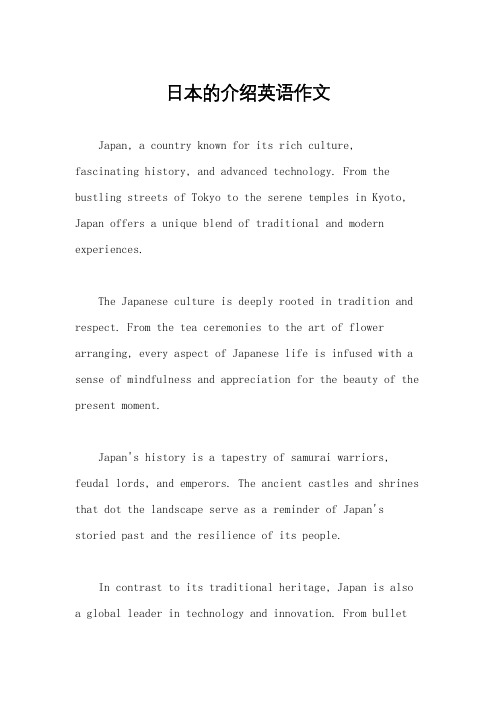
日本的介绍英语作文Japan, a country known for its rich culture,fascinating history, and advanced technology. From the bustling streets of Tokyo to the serene temples in Kyoto, Japan offers a unique blend of traditional and modern experiences.The Japanese culture is deeply rooted in tradition and respect. From the tea ceremonies to the art of flower arranging, every aspect of Japanese life is infused with a sense of mindfulness and appreciation for the beauty of the present moment.Japan's history is a tapestry of samurai warriors, feudal lords, and emperors. The ancient castles and shrines that dot the landscape serve as a reminder of Japan's storied past and the resilience of its people.In contrast to its traditional heritage, Japan is also a global leader in technology and innovation. From bullettrains to robots, Japan is at the forefront of cutting-edge advancements that continue to shape the world.The natural beauty of Japan is also a sight to behold. From the snow-capped peaks of Mount Fuji to the cherry blossoms that blanket the country in spring, Japan's landscapes are diverse and breathtaking.The cuisine of Japan is a culinary delight, with sushi, ramen, and tempura being just a few of the many delicious dishes that have captivated the world.In conclusion, Japan is a country of contrasts, where ancient traditions coexist with modern marvels, and where the past and the future converge in a harmonious blend. It is a place that offers something for everyone, whether you are a history buff, a tech enthusiast, or a nature lover. Japan truly is a one-of-a-kind destination that leaves a lasting impression on all who visit.。
描述日本风俗文化英语作文

Title: Embracing the Unique Customs andCulture of JapanJapan, an island nation steeped in history and tradition, presents a fascinating tapestry of customs and culture. From the elegant precision of its tea ceremony to the vibrant energy of its festivals, Japan offers a rich palette of experiences that are both enchanting and enlightening.The heart of Japanese culture lies in its respect for tradition and reverence for nature. This is reflected in the meticulous attention to detail in all aspects of daily life, whether it's the meticulous care taken in preparing a meal or the precision with which tea is poured during the tea ceremony. The tea ceremony, known as "sado," is notjust about drinking tea; it's an elaborate ritual that involves the harmonious interaction of host and guest, the appreciation of the beauty of nature, and the pursuit of inner peace.Another hallmark of Japanese culture is its emphasis on community and collective harmony. This is evident in the way Japanese people greet each other with bows and politephrases, demonstrating respect and consideration for others. The concept of "wa," which translates to harmony or unity,is ingrained in Japanese society and is reflected invarious aspects of life, from social interactions to theway businesses are conducted.Festivals and celebrations are an integral part of Japanese culture, with each season marked by special events and traditions. The cherry blossom viewing, known as "sakura-viewing," is a national obsession, with people flocking to parks and temples to admire the delicate beauty of the flowers. The autumn moon viewing, on the other hand, is a time for family reunions and the appreciation of thefull moon against the backdrop of autumn foliage.The visual arts of Japan are also a testament to itsrich cultural heritage. From the delicate brushstrokes of traditional Japanese painting to the intricate carvings of lacquerware, Japanese artists have perfected the art of combining beauty and functionality. The art of origami, the folding of paper into intricate shapes, is another exampleof Japanese creativity and craftsmanship.In conclusion, Japan's customs and culture are atapestry of tradition, harmony, and natural beauty. Fromthe precision of its tea ceremony to the vibrantcelebrations of its festivals, Japan offers a unique and enchanting experience that leaves a lasting impression on those who visit. Embracing these customs and traditions,one can truly appreciate the depth and richness of Japanese culture.**拥抱日本独特的风俗文化**日本,这个岛屿国家拥有丰富的历史和传统,展现了一幅迷人且多姿多彩的风俗文化画卷。
日本生活文化介绍英文作文
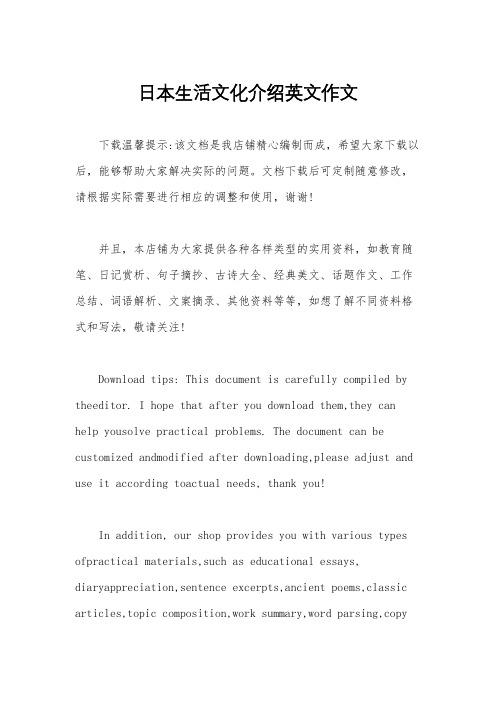
日本生活文化介绍英文作文下载温馨提示:该文档是我店铺精心编制而成,希望大家下载以后,能够帮助大家解决实际的问题。
文档下载后可定制随意修改,请根据实际需要进行相应的调整和使用,谢谢!并且,本店铺为大家提供各种各样类型的实用资料,如教育随笔、日记赏析、句子摘抄、古诗大全、经典美文、话题作文、工作总结、词语解析、文案摘录、其他资料等等,如想了解不同资料格式和写法,敬请关注!Download tips: This document is carefully compiled by theeditor. I hope that after you download them,they can help yousolve practical problems. The document can be customized andmodified after downloading,please adjust and use it according toactual needs, thank you!In addition, our shop provides you with various types ofpractical materials,such as educational essays, diaryappreciation,sentence excerpts,ancient poems,classic articles,topic composition,work summary,word parsing,copyexcerpts,other materials and so on,want to know different data formats andwriting methods,please pay attention!Japan is a country with a rich and diverse culturallife. From traditional tea ceremonies to modern pop culture, there is something for everyone in Japan.One of the most well-known aspects of Japanese cultureis its cuisine. Japanese food is not only delicious, butalso beautiful in its presentation. From sushi to ramen, there is a wide variety of dishes to try. And let's not forget about the famous Japanese tea ceremony, a ritualthat has been practiced for centuries.In addition to food, Japan is also famous for its traditional arts such as ikebana (flower arranging) and origami (paper folding). These art forms require precision and patience, and are a reflection of the Japanese value of simplicity and elegance.When it comes to fashion, Japan is at the forefront of trends. The Harajuku district in Tokyo is known for itsstreet fashion, where young people express themselves through their clothing and accessories. On the other hand, the kimono, a traditional Japanese garment, is still wornon special occasions and is a symbol of Japanese cultural identity.Japanese festivals are another important part of lifein Japan. From the cherry blossom festival to the lantern festival, these events bring people together to celebrate and enjoy traditional performances, food, and drinks.Finally, Japan is also known for its modern pop culture, including anime, manga, and video games. These forms of entertainment have a global following and have had a significant impact on popular culture around the world.In conclusion, Japan's cultural life is diverse and vibrant, blending traditional customs with modern trends. Whether it's food, art, fashion, or entertainment, there is something for everyone to enjoy in Japan.。
介绍外国文化特色的英语作文

介绍外国文化特色的英语作文英文回答:Culture is an integral part of a country's identity, and each country has its own unique cultural characteristics. In this essay, I will introduce some distinctive features of foreign cultures.Firstly, let's talk about Japanese culture. One of the most notable aspects of Japanese culture is its emphasis on politeness and respect. In Japan, people bow as a form of greeting, and it is considered impolite to speak loudly in public places. Additionally, the concept of "saving face" is highly valued in Japanese society. This means that people try to avoid causing embarrassment or shame to themselves or others. For example, if a Japanese person makes a mistake, they might apologize profusely and try to rectify the situation immediately.中文回答:文化是一个国家身份的重要组成部分,每个国家都有自己独特的文化特色。
介绍日本的英语作文

介绍日本的英语作文英文回答:Japan, a land of vibrant culture, technological advancements, and natural beauty, has long captivated the world's imagination. From its ancient traditions to its modern metropolises, Japan offers a unique and fascinating blend of history and modernity.Geography and Climate:Situated in the northwestern Pacific Ocean, Japan consists of four main islands: Hokkaido, Honshu, Shikoku, and Kyushu. It boasts a diverse terrain ranging from towering mountains to pristine beaches, with Mount Fuji as its iconic symbol. Japan's climate varies from humid subtropical in the south to humid continental in the north, with distinct seasons that showcase the country's natural beauty.History and Culture:Japan has a rich and storied history dating back to prehistoric times. From the feudal era to the Meiji Restoration, the country has undergone significant transformations. Japanese culture is deeply influenced by its ancient traditions, including Shintoism, Buddhism, and Confucianism. This reverence for tradition is evident in the country's festivals, arts, and daily life.Language and Education:The official language of Japan is Japanese, a complex and nuanced language with a unique writing system. English is widely spoken in major cities and tourist areas, but fluency is not common among the general population. Japan's education system is renowned for its rigor and emphasis on academic excellence, with students consistently ranking among the top performers in international assessments.Technology and Infrastructure:Japan is a global leader in technological innovation, with cutting-edge advancements in robotics, electronics, and transportation. The country boasts a highly developed transportation network, including bullet trains that connect major cities at incredible speeds. Japan's infrastructure is highly advanced, providing convenient and efficient access to utilities, services, and public spaces.Economy and Industry:Japan is the world's third-largest economy, with a strong manufacturing sector and a vibrant service industry. The country is home to global giants such as Toyota, Honda, and Sony. Japan's economy is highly export-oriented, with a focus on high-value goods like electronics, vehicles, and machinery.Tourism and Travel:Japan offers an unforgettable tourist experience, with a wealth of natural attractions, cultural landmarks, and modern amenities. From the bustling streets of Tokyo to theserene temples of Kyoto, Japan caters to every traveler's interest. The country's efficient transportation system makes it easy to explore its diverse regions and cultural sites.People and Society:The Japanese people are known for their politeness, hospitality, and respect for tradition. Japanese society places great importance on community and social harmony. While Japan has a modern and rapidly changing society, it also cherishes its ancient traditions, creating a harmonious fusion of old and new.Challenges and Future:Like all countries, Japan faces its share of challenges. These include an aging population, a shrinking workforce, and the need to balance economic growth with environmental protection. However, Japan's resilience and adaptability have historically allowed it to overcome obstacles andforge a path toward a prosperous and sustainable future.中文回答:日本概况。
日本的文化英语作文
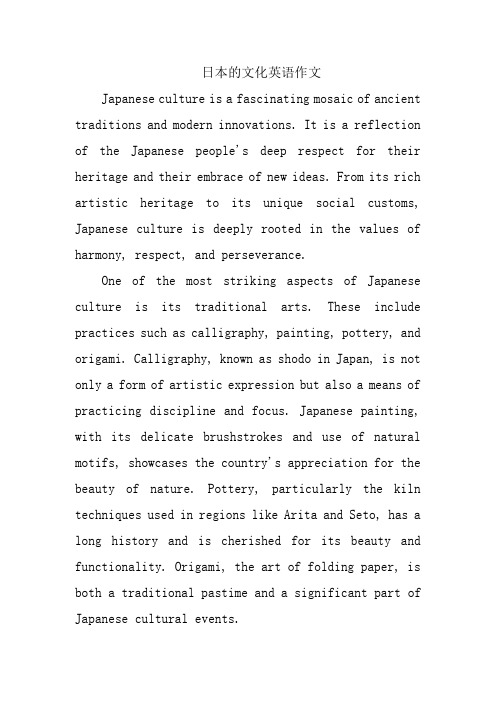
日本的文化英语作文Japanese culture is a fascinating mosaic of ancient traditions and modern innovations. It is a reflection of the Japanese people's deep respect for their heritage and their embrace of new ideas. From its rich artistic heritage to its unique social customs, Japanese culture is deeply rooted in the values of harmony, respect, and perseverance.One of the most striking aspects of Japanese culture is its traditional arts. These include practices such as calligraphy, painting, pottery, and origami. Calligraphy, known as shodo in Japan, is not only a form of artistic expression but also a means of practicing discipline and focus. Japanese painting, with its delicate brushstrokes and use of natural motifs, showcases the country's appreciation for the beauty of nature. Pottery, particularly the kiln techniques used in regions like Arita and Seto, has a long history and is cherished for its beauty and functionality. Origami, the art of folding paper, is both a traditional pastime and a significant part of Japanese cultural events.Japanese cuisine, known as washoku, is world-renowned for its delicate flavors, intricate presentation, and emphasis on seasonal ingredients. Dishes such as sushi, tempura, and ramen have gained global popularity, reflecting the influence of Japanese cuisine on world food cultures. The art of tea ceremony, orchanoyu, is another important aspect of Japanese culture, symbolizing harmony, respect, and tranquility.Social customs in Japan are characterized by a strong sense of etiquette and respect. The concept of omotenashi, or hospitality, is deeply ingrained in Japanese society. This is evident in the attention to detail in service industries, the importance of gift-giving, and the practice of bowing as a form of greeting. The Japanese people's respect for elders and their commitment to maintaining harmony in social interactions are also notable aspects of Japanese culture.In recent years, Japanese culture has also influenced global trends in fashion, animation, and technology. Japanese street fashion, with its bold andinnovative styles, has captured the imagination of fashion enthusiasts worldwide. Anime and manga, Japanese forms of graphic storytelling, have become global phenomena, introducing Japanese cultural elements to audiences far and wide.In conclusion, Japanese culture is a unique blend of tradition and modernity. Its rich heritage and innovative practices continue to inspire and captivate people around the world. The Japanese people's dedication to preserving their cultural traditions while embracing new ideas is a testament to the dynamic and fascinating nature of Japanese culture.中文翻译:日本文化是一幅由古老传统和现代创新构成的迷人马赛克。
日本生活文化介绍英文作文
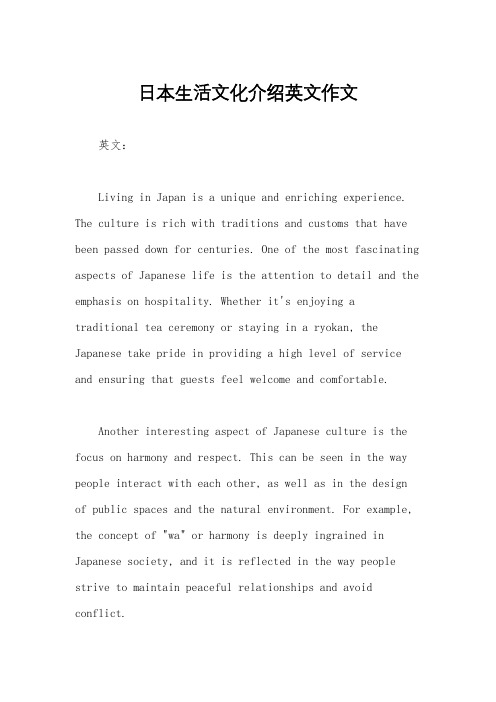
日本生活文化介绍英文作文英文:Living in Japan is a unique and enriching experience. The culture is rich with traditions and customs that have been passed down for centuries. One of the most fascinating aspects of Japanese life is the attention to detail and the emphasis on hospitality. Whether it's enjoying atraditional tea ceremony or staying in a ryokan, the Japanese take pride in providing a high level of service and ensuring that guests feel welcome and comfortable.Another interesting aspect of Japanese culture is the focus on harmony and respect. This can be seen in the way people interact with each other, as well as in the design of public spaces and the natural environment. For example, the concept of "wa" or harmony is deeply ingrained in Japanese society, and it is reflected in the way people strive to maintain peaceful relationships and avoid conflict.In addition, the food culture in Japan is truly exceptional. From fresh sushi and sashimi to hearty bowls of ramen, Japanese cuisine is diverse and delicious. I have had the pleasure of trying many different types of Japanese dishes, and each one has left a lasting impression on me. The attention to presentation and the use of seasonal ingredients make dining in Japan a memorable experience.Living in Japan has also given me the opportunity to participate in various cultural activities, such as wearing a kimono, learning the art of origami, and attending traditional festivals. These experiences have allowed me to gain a deeper understanding and appreciation for Japanese culture.Overall, life in Japan is a wonderful blend oftradition and modernity, and I feel fortunate to have the chance to immerse myself in such a unique and captivating culture.中文:生活在日本是一种独特而丰富的体验。
英文版日本文化介绍 Japanese culture

creamy sauces and strong smelling foods
Food & Drink in China
Chinese habits:
•always a cup, a bowl on a small dish, together with the chopsticks and table spoons •cooked food •whole plate of dishes for everyone •accompanied by tea, beer or distilled spirit •required to keep silent
Long term orientation
•See their life as a very short moment in a long history of mankind
•Live their lives guided by virtues and practical good examples
avoid
in obtrusive way complain directly
Business Etiquette in Japan
Rachel
Appointments Appearance Meet & Greet Business cards Business seating order Business dealings Decisions & Contracts Giving gifts
Business Customs in Japan
ONE
Overall Situation of Japan
TWO
介绍日本的英文作文
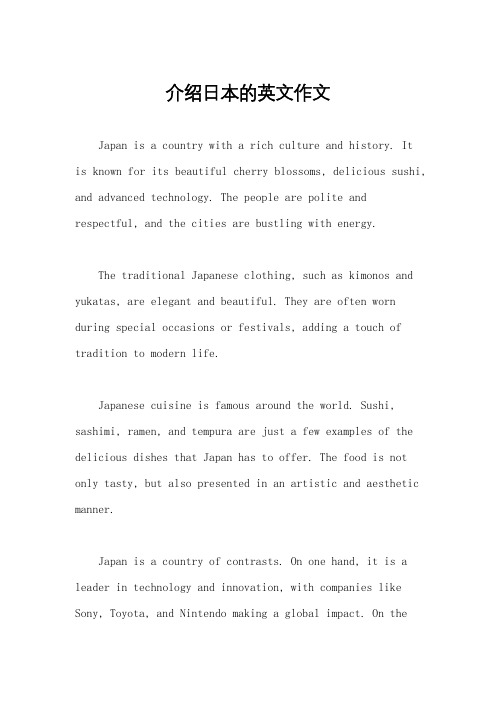
介绍日本的英文作文Japan is a country with a rich culture and history. Itis known for its beautiful cherry blossoms, delicious sushi, and advanced technology. The people are polite and respectful, and the cities are bustling with energy.The traditional Japanese clothing, such as kimonos and yukatas, are elegant and beautiful. They are often worn during special occasions or festivals, adding a touch of tradition to modern life.Japanese cuisine is famous around the world. Sushi, sashimi, ramen, and tempura are just a few examples of the delicious dishes that Japan has to offer. The food is not only tasty, but also presented in an artistic and aesthetic manner.Japan is a country of contrasts. On one hand, it is a leader in technology and innovation, with companies like Sony, Toyota, and Nintendo making a global impact. On theother hand, it also has many traditional practices and beliefs that have been preserved for centuries.The natural beauty of Japan is breathtaking. From the majestic Mount Fuji to the serene cherry blossom gardens, there is no shortage of stunning landscapes to admire. The country is also known for its hot springs, or onsen, which are popular for relaxation and rejuvenation.Japanese pop culture, including anime, manga, and J-pop, has a huge following worldwide. The creativity and imagination of Japanese artists and creators have captured the hearts of people from all over the globe.In conclusion, Japan is a fascinating and diverse country with a unique blend of tradition and modernity. Its rich culture, delicious food, beautiful landscapes, and vibrant pop culture make it a truly special place toexplore and experience.。
日本文化介绍(全英文版)
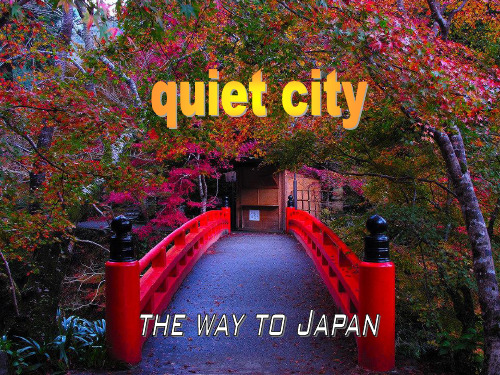
Composition
• The main islands, sometimes called the "Home Islands", are (from north to south) Hokkaidō, Honshū (the "mainland"), Shikoku and Kyūshū. There are also about 3,000 smaller islands, including Okinawa, and islets, some inhabited and others uninhabited. In total, as of 2006, Japan's territory is 377,923.1 km² , of which 374,834 km²is land and 3,091 km²water. This makes Japan's total area slightly smaller than the U.S. state of Montana, slightly bigger than the Brazilian state of Mato Grosso do Sul. Japan is bigger than Germany, Malaysia, New Zealand and the U.K., and is 1.7 times the (和服)
The kimono is a Japanese traditional garment worn by women, men and children. The word "kimono", which literally means a "thing to wear" (ki "wear" and mono "thing"), has come to denote these full-length robes. The standard plural of the word kimono in English is kimonos,[but the unmarked Japanese plural kimono is also sometimes used. Kimono are T-shaped, straight-lined robes worn so that the hem falls to the ankle, with attached collars and long, wide sleeves. Kimono are wrapped around the body, always with the left side over the right (except when dressing the dead for burial),[and secured by a sash called an obi, which is tied at the back. Kimono are generally worn with traditional footwear and split-toe socksToday, kimono are most often worn by women, and on special occasions. Traditionally, unmarried women wore a style of kimono called furisodewith almost floor-length sleeves, on special occasions. A few older women and even fewer men still wear the kimono on a daily basis. Men wear the kimono most often at weddings, tea ceremonies, and other very special or very formal occasions. Professional sumo wrestlers are often seen in the kimono because they are required to wear traditional Japanese dress whenever appearing in public
描述日本风俗文化英语作文
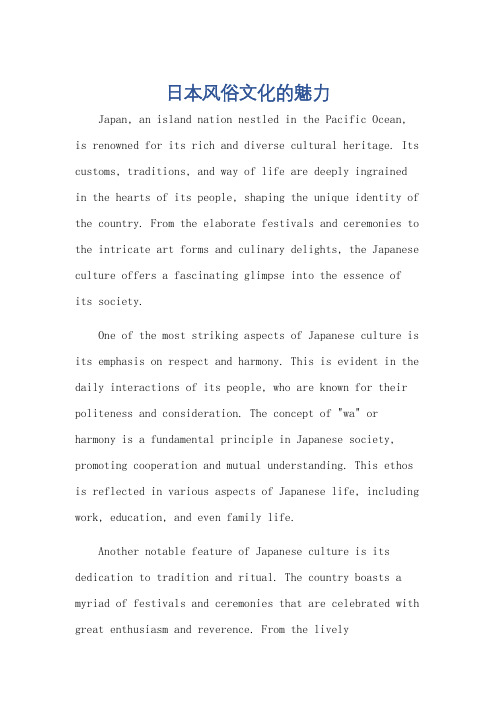
日本风俗文化的魅力Japan, an island nation nestled in the Pacific Ocean,is renowned for its rich and diverse cultural heritage. Its customs, traditions, and way of life are deeply ingrainedin the hearts of its people, shaping the unique identity of the country. From the elaborate festivals and ceremonies to the intricate art forms and culinary delights, the Japanese culture offers a fascinating glimpse into the essence ofits society.One of the most striking aspects of Japanese culture is its emphasis on respect and harmony. This is evident in the daily interactions of its people, who are known for their politeness and consideration. The concept of "wa" or harmony is a fundamental principle in Japanese society, promoting cooperation and mutual understanding. This ethos is reflected in various aspects of Japanese life, including work, education, and even family life.Another notable feature of Japanese culture is its dedication to tradition and ritual. The country boasts a myriad of festivals and ceremonies that are celebrated with great enthusiasm and reverence. From the livelycelebrations of the New Year to the solemn rituals of Shinto and Buddhism, these events provide a window into the deep-rooted beliefs and values of the Japanese people.The Japanese arts are also renowned worldwide for their uniqueness and elegance. From the graceful movements of traditional dance to the intricate details of pottery and painting, these art forms reflect the aestheticsensibilities and creative spirit of the Japanese. The tea ceremony, in particular, is a testament to the Japanese appreciation for simplicity and natural beauty.Moreover, Japanese cuisine is a testament to the country's rich culinary heritage. The meticulous preparation of dishes, the emphasis on seasonality and freshness, and the harmonious blending of flavors all contribute to the unique charm of Japanese food. From sushi and ramen to tempura and izakaya, these culinary delights are not only a pleasure for the taste buds but also a journey through the rich history and culture of Japan.Furthermore, the Japanese way of dressing, known as "kimono," is another emblem of the country's cultural identity. The intricate patterns and vibrant colors of thekimono reflect the artistic sensibilities of the Japanese, while the act of dressing in a kimono itself is aritualized process that强调了尊重和谦逊的文化价值。
用英语介绍的日本文化
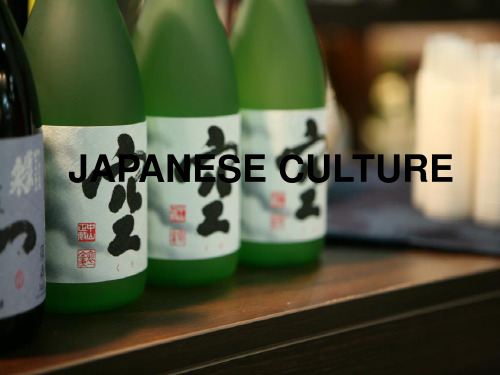
Tokyo Goul
THANKS!
• Japan is the world's largest animation powerful • country. Japanese started from 1917,it has 99 years for now.
anime
[ˈænɪmeɪ
and now it grows faster and faster .......
ceremonies [ˈserəməni]
funeral kimonos
[ˈfju:nərəl] [kɪˈməʊnəʊ]
Hot spring
A hot spring bath proves to be an efficient therapy(疗法) for one to keep fit as well as a miraculous(超 自然的,奇迹般的) way of skin care.
JAPANESE CULTURE
Food
sushi (a kind of Japanese food)
Sushi is a kind of rice topped with vegetables. It is a spectacular combination of various ingredients including rice, fish and vinegar and is the most representative Japanese cuisine.寿司是一种带菜码的米饭团,是 一种最具有代表性的日本民族料理,它是米饭、鱼、醋巧妙组合的结晶.
Here are some famous animation Let's have a look~
japenese culturl

The staple of the Japanese diet is rice, rice and soybean curd soup(酱汤) being common breakfast foods.
Sushi is a kind of rice topped with vegetables. It is a Spectacular combination of various ingredients including rice, fish and vinegar and is the most representative Japanese Cuisine(烹饪) Sushi indicates dishes that use sushi rice, which is seasoned with a sweet vinegar (醋) mixture. Although you can make sushi without using any fish/raw fish, many kinds of fish are used in sushi dishes.
Takoyaki 章鱼烧
A popular Japanese dumpling made of batter, diced octopus(章鱼丁), pickled ginger(姜) and green onion, topped with sauce, and fish shavings, originating from Osaka(大阪).
和服
汉服
cherry blossom
Japan's cherry blossoms every year from south to north sequence flowering
日式美食英语作文带翻译

日式美食英语作文带翻译Title: Exploring the Delights of Japanese Cuisine。
Japan is renowned worldwide for its rich culinary heritage, characterized by delicate flavors, meticulous preparation, and a profound respect for seasonal ingredients. In this essay, we delve into the captivating realm of Japanese cuisine, exploring its diverse dishes, cultural significance, and enduring appeal.首先,让我们来探讨日式料理的多样性。
日本料理不仅仅是寿司和寿面。
它包括了各种各样的食物,从传统的日本早餐,如清汤和米饭,到精致的樱花盛宴,每一道菜都展示了独特的美味和独特的风味。
寿司,作为日本料理的代表,以其新鲜的鱼肉和完美的米饭而闻名。
刺身,寿司的一种形式,强调了食材的原始味道,体现了日本料理的简洁和精致。
Next, let's delve into the diversity of Japanese cuisine. Japanese food encompasses far more than just sushi and ramen. It includes a wide array of dishes, fromtraditional Japanese breakfasts featuring miso soup and rice, to elaborate cherry blossom feasts where each dish showcases unique flavors and textures. Sushi, as a quintessential representation of Japanese cuisine, is renowned for its fresh fish and perfectly seasoned rice. Sashimi, a form of sushi, emphasizes the purity of ingredients, reflecting the simplicity and refinement of Japanese cuisine.日本料理的文化意义也不容忽视。
